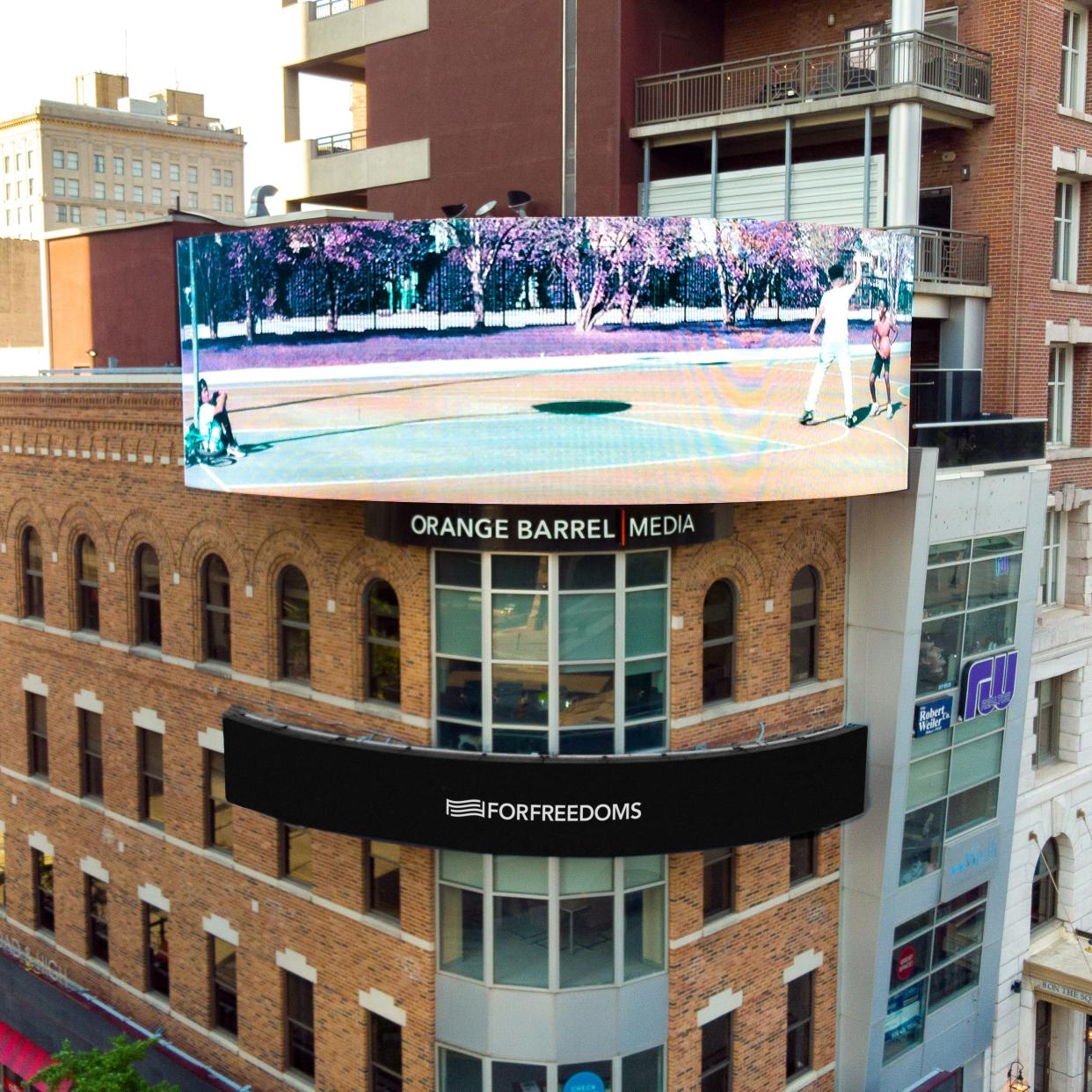Downtown Columbus billboard's picture part of a national justice campaign

A billboard at the corner of Broad and High streets recently featured a photo of three Black boys on a basketball court for most of the month of June.
There was no text. Just three boys, one sitting under the hoop staring at the camera and two playing a game.
On the surface, it’s simple, but the meaning is more nuanced than it appears. With no message, it left people to interpret the meaning on their own. Freedoms executive director, Claudia Pena, likes that about the image.
"I love when something doesn’t have text to direct you and you can interpret it,” Pena said. “I’m so quick to think of all the things it could mean. Are we talking about access to play spaces? Are we talking about a critique of sport?"
Boys playing basketball: So, what was the billboard about?
In this case, the photo, titled "You Talk Over a Beat" and taken by photographer Anwulika Anigbo, who is also title director of development for the Chicago-based Invisible Institute, is part of a project organized by For Freedoms, a national art collective. The project is meant to make people think deeper about social issues, and this project specifically was called, "Another Justice by Any Medium Necessary."
“It’s made up of billboards all that answer the question, ‘What does justice mean to you?’” Pena said.
Travel: Record number of Ohioans expected to travel for Independence Day, all summer long
For Anigbo, a 34-year-old from Chicago, it was a chance to spread her message of what childhood means for Black boys and girls. Even though the billboard was shown only through June, she accomplished her goal.
"I wanted to depict an image of what childhood really is, in its stillness and its beauty,” she said. “Just present an image of Black children for everyone to see and contemplate just the way that Black boys and women are children first. We exist in the same way other people exist. I think childhood is just such an important time that is taken from us.”
Anigbo is relatively new to film photography. An artist most of her life, she put some of her dreams on hold in college at Indiana University when her first child was born. An art major with a child, trying to pay back student loans, wasn’t going to move the needle when she graduated in 2011.
"It was just not going to work out,” she said.
She kept photography as a hobby, though, and added Polaroid and film photography to her list of talents during the pandemic.
That’s when her billboard picture was taken, in 2020, with the pandemic shutting down schools across the country. She thought it was a good time to capture what was going on, and after For Freedoms reached out to her about collaborating, she thought she had the perfect photo for them.
Not only was it a vivid photo, it also portrayed a vision she had.
"A lot of my work really focuses on reflecting Blackness to Black people. It comes from my experience as a young Black mother, single and really needing to capture and reflect my experience back to myself,” she said.
Art awards: Greater Columbus Arts Council awards more than $8 million through two largest grant programs
“They are doing their own thing on the basketball court. … It reminds me of the Lupe Fiasco song ‘Kick, Push.’ He talks about in that song when things get crazy, they needed to break out and I think about that. … That song is really like, ‘Hey, we’re out here and we’re going to make a world, skate around and have fun.’
"I love that sort of reminiscing, the way children try to own themselves. When we talk about liberation, we need to talk about childhood. I don’t think you can have liberation without play. That’s something that gets taken from us very early, the ability to just play.”
For Freedoms group uses billboards to promote ideas
This isn’t the first time For Freedoms has placed billboards around the country.
Pena, who lives in California, said the billboard campaign began in 2018, and the goal was to hang billboards in every state. To achieve what they wanted with the project, they had to have a diverse group of artists and they have that again with this campaign.
All of the billboards posted in more than 25 cities around the country were created by a mix of incarcerated people, formerly incarcerated, victims of crimes, the surviving family members of victims, district attorneys, public defenders, activists and more.
Visual arts: The Great Depression meets modern pandemic in 'Chronicles' photo exhibit
It also includes people who don’t consider themselves artists.
Anigbo is not one of those people. She is an artist through and through, and Pena knows that. She was impressed on her first look at the picture she used for the Columbus billboard, and still is.
There’s a challenge in deciding which billboards go up in which cities for the campaign. Some artists have a request for where they go, some are tailored to a specific region, but Pena thought Anigbo’s picture was universal and could work anywhere.
When Anigbo first saw it up, she was taken aback. Her work was on a building in Downtown Columbus.
"I was just happy to have a billboard. I was like, ‘Wow,’” she said.
And though it might have appeared as a simple picture of three kids playing basketball, there was so much more meaning in every inch of the frame.
Cameron Teague Robinson CTeagueRob@gannett.com; Twitter: @cj_teague
This article originally appeared on The Columbus Dispatch: Mystery solved on Downtown billboard of boys playing basketball

